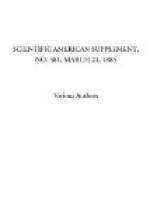The instrument, as usually constructed, is shown in Figs. 2 and 3.
The reservoir, RR’ contains the measuring drum, mmmm, movable around the horizontal axis, aa’. The gas enters at E, passes at S into an opening that may be closed by a valve, and is distributed through the box, BB’, which communicates with the reservoir through an orifice in the partition, hh’. This orifice is traversed by the axle, aa’. The box, like the reservoir, contains water up to a certain level, r. Through a U-shaped tube, lnl’, the gas passes from the box, BB’, into the movable drum, sets the latter in motion, and makes its exit at S. In order to count the volume discharged, that is to say, the number of revolutions of the drum, the axle terminates at a in an endless screw which, by means of a cog wheel, moves a vertical rod that traverses the tube, gg, and projects from the box. As the tube, gg, dips into the water, it does not allow the gas to escape, and this permits of the revolution counter that the rod actuates being placed in an external case, CC’.
The counter consists of toothed wheels and pinions so arranged that if the first wheel makes one complete revolution corresponding to a discharge of 1,000 liters, the following wheel, which indicates cubic meters, shall advance one division, and that if this second wheel makes one complete revolution marked 10 cubic meters, the third, which indicates tenths, shall advance one division, and so on. Hands fixed to the axles of the wheels, and movable over dials, permit the volume of gas to be read that has traversed the counter.
The object of the other parts of the instrument are to secure regularity in its operation by keeping the level of the liquid constant. It is evident, in fact, that if the level of the water gets below r, the capacity of the buckets will be increased, and the counter will indicate a discharge less than is really the case, and vice versa. If the level descends as far as to the orifice in the partition, hh’, the gas will flow out without causing the apparatus to move. The water is introduced into the counter through f, which is closed with a screw cap, and passes through the opening shown by dotted lines into the reservoir, RR’, whence it flows to the box, BB’, When it has reached the desired level, it gains the orifice, r, of a waste pipe, escapes through the siphon, ruv, and makes its exit through the aperture, b’, when the screw cap of the latter is removed. If, by accident, the level of the water should fall below a certain limit, a float, f, which follows its every movement, would close the valve, s, and stop the flow of the gas. Finally a tube, tt’ soldered to the lower part of the tube, lnl’, and dipping into the water of a compartment, P, serves to allow the surplus water to flow out at b’. To prevent the apparatus from being disarranged upon the drum being revolved in the opposite direction, there is fixed to the axle, aa’, a cam which lifts a click, z, when the rotation is regular, but which is arrested by it when the contrary is the case.—Science et Nature.




